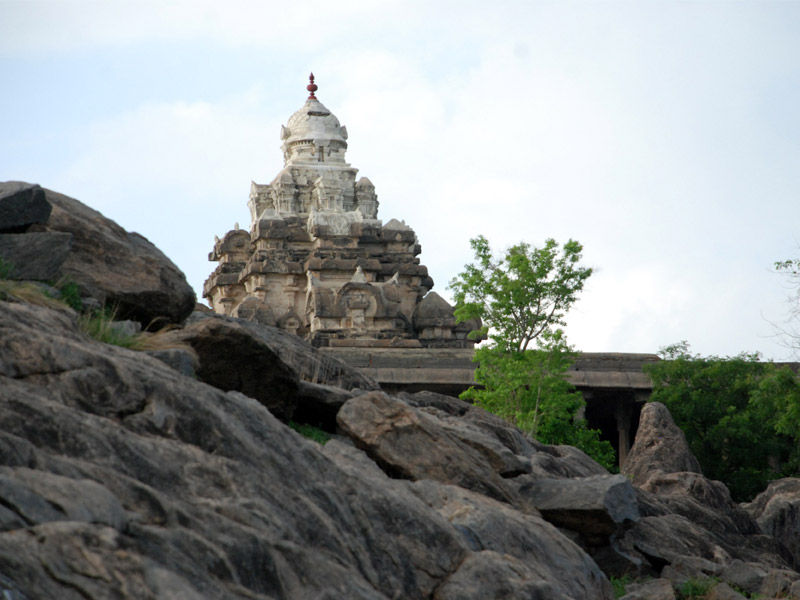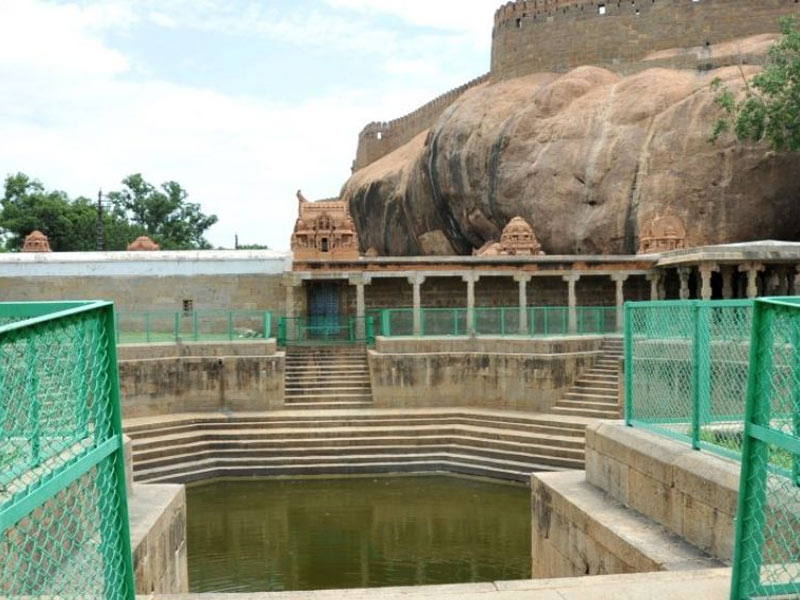Thirumayam Fort is a 40-acre castle located near Thirumayam on the Pudukkottai-Karaikudi Highway in Pudukkottai District, Tamil Nadu, India. It was built in 1687 by Vijaya Raghunatha Sethupathi, Raja of Ramnad. The Fort was afterward passed on to his brother-in-law, Raghunatha Raya Tondaiman. In 2012, the Archaeological Survey of India completely repaired the Fort. The Fort was initially described as a “ring fort” with seven concentric walls, but only four remain now. The Fort’s construction is of poor quality because tiny chunks of stone were used with bricks to create the fortress.

The Fort was initially described as a “ring fort” with seven concentric walls, but only four remain now. The Fort’s construction is of poor quality because tiny chunks of stone were used with bricks to create the fortress.
There are three entrances to the Fort: one on the north, one on the south, and one on the east. On the southern side, there are shrines devoted to Hanuman, Sakthi, Ganapathi, and Karuppar (Fort’s guardian deities). In contrast, on the northern side, there is a temple dedicated to Bhairava. A chamber used as a magazine was discovered halfway up the right side.
On top of the rock lies a stronghold with British-made cannons. A natural pond may be found to the south of this Platform. There are two rock-cut temples on the southern slope, one devoted to Sri Sathyamurthy-Sri Uyyavanda Nachiar (Vaishnavite) and the other to Sri Sathyagireeswarar-Sri Venuvaneeswari (Saivite), which is more historically and spiritually significant. Another pond may be found to the northwest, while another tank can be found to the southeast. Six additional guns are stationed at the north, south, and east gates.
The fortification has significant historical significance as a bastion of rebel chieftains during the Polygar Wars. In this Fort, Oomathurai, the brother of Panchalankurichi chieftain Kattabomman, was apprehended. Oomayan Kottai is the native name for the Fort (Fort of the dumb). The Archaeological Survey of India maintains and manages the Fort as a ticketed monument.

The Raja of Ramnad, Sethupathy Vijaya Ragunatha Thevar, has erected the Thirumayam Fort in 1687 AD. Ragunatha Raya Tondaiman, his brother-in-law, eventually took over the Fort. The Fort has an unusual ring configuration and is built with seven concentric walls encircled by a wide moat. However, only four such walls remain now. The Fort’s structure, made of tiny stone blocks and bricks, lacks workmanship. The modern Fort is built on a 40-acre plot of land, although the original building was at least twice as massive as what is seen now.
Also Read, Bada Bagh: A Secluded Wonder in Rajasthan
The Archaeological Survey of India manages the Thirumayam Fort, which was significantly rebuilt in 2012 since it is an important landmark and a prominent tourist destination in the Pudukkottai area. The Fort has three entrances on its sides: northern, southern, and eastern. The Fort’s main entrance is roughly a kilometer away from the current construction. It features two guns installed on each entry gate.
On the northern side, halfway to the foot of the hilltop, there is a rock-cut Shiva temple carved out of the side of a massive boulder. A Durbar Hall with carved inscriptions and a pillared hallway are also present. Another old temple on the southern side is dedicated to Hanuman, Ganapathi, Sakthi, and Karuppar, the Fort’s guardian deities. A natural pond may be found on the north-western side, while another tank can be found to the southeast. The Pampa River flows in front of the Shiva temple, where Shiva is worshipped as Bhairava, a violent form of Lord Shiva. The latter is considered the defender of all living creatures in the Fort’s vicinity.

During the Polygar Wars, this Fort was historically significant. During World War II, the British army utilized it as an armory. This historic property is now serene and available to the public.
It’s simple to get here because it’s conveniently accessible by rail, road, and air. You might stay at the majestic Chidambara Vilas historic hotel and experience life as it was in the past.
Investigation of Thirumayam Fort Pudukkottai

- The fort complex contains multiple temples devoted to various Gods and Goddesses. It was common for prayers to be said for a battle to be declared a success.
- The Satyagirisvara Temple, a Shiva temple, and the Satyamurti Perumal Temple, a Vishnu temple, are two.
- The other temples on the southern side are devoted to Hanuman, Sakthi, Ganapathi, and Karuppar (Fort’s guardian deities). In contrast, the shrine on the northern side is dedicated to Bhairava.
- On top of the hilltop lies a fortress with British-made cannons. Six additional guns are installed on the north, south, and east gateways.
- Local tourists posture in a titanic pose and get their photos taken there.
What is the best way to get to Thirumayam Fort?

Take the train: Chettinad Railway Station is the nearest railway station.
By car: The Fort is on the Pudukkottai-Karaikudi route. The road that connects Tiruchirapalli and Rameshwaram is NH210. It is 407 kilometers from Bangalore by NH44 with tolls and can be completed in around 7 hours. It is 538 kilometers long and takes around 9 hours to complete via NH48 and NH38.
Tickets and Hours of Operation
- Every day of the week from 8 a.m. to 5 p.m.
- The tickets were inexpensive.




























